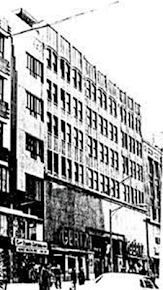It has been twelve years since I have blogged on this old site. Even so, I retain a fondness for when I began it as an ancillary resource for a class that I once taught as well as for the Manhattan walking tours that I still run for the St. John's University Honors Program. I continue to direct this program, essentially because it has become an important part of my life in teaching.
New York City, in which I was born and continue to live, work, and teach, has also remained at the center of my interests and concerns. We New Yorkers have gone through so much in the past decade, from superstorms, to pandemics, to increasing crime, to a deteriorating economy that I sometimes wonder how we have endured; yet, we have albeit with the scars and legacies such horrific things bring.
Many of us fear the very streets we have walked all our lives, not to mention the public transportation we have utilized since adolescence. Tabloid media have frequently exploited and sensationalized the worst of New York and, depending upon whether right-wing or left, have never hesitated to find scapegoats. I am sure that there are politicians who care about the city, but their immediate points of reference invariably are their political supporters. Religion too has become increasingly polarized and intolerant and has lost moral credibility.
The reader of this essay, if indeed anyone does read it, will notice that I have tried to state self-evident facts. Another fact is that New York City has been violent and dangerous at the most critical periods of its development. Dutch merchants feared that the English farmers in the northern village the British called Greenwich would intrude on New Amsterdam, and so they built a wall, only ten feet high and made of wood, but it marked the Dutch / English property line, so to speak, at Wall Street.
After 1664 when the British naval ship Asia fired a single shot into the water at what today we call the Narrows,
Peter Stuyvesant and his militia put on a brave show marching up and down
Broadway and attempting to incite the burgers to resist, but a bit after noon
and without the sanction of the Dutch East India Company, New Amsterdam became
New York. This spurred the city's first infrastructure project: removing
the toll stations and wall and constructing a major farmer's road called
Greenwich Street. The path of the street is still as it was at the
earliest incarnation of Jefferson Market, moving diagonally downtown and
crossing what is today the Avenue of the Americas (Sixth Avenue).

Today's Jefferson Market, a national landmark building dating from 1874, once a farmer's market, then a jail and a courthouse, is today a branch of the New York Public Library. Its exterior is a wonderous folly which easily might make some New Yorkers think of the Fantasyland Castle at Disneyland. That the city still cares enough to renovate its interior to create a contemporary library is encouraging for the city’s future.
During the Revolutionary War, 1776-1783, the Sons of Liberty terrorized the pro-British merchants of occupied New York by burning or vandalizing their homes or by plamting a burning oak mast stole from the British storehouses on the Eastside waterfront.
The Roman Catholic church at Barclay Street we call nowadays "Old St. Peter's" was built on the edge of a 1712 landgrant by Queen Anne to the Duke of York. The original church building on this site, dating from 1785, was the scene of a nativist riot on Christmas Eve, 1806 by a street gang called the Highbinders, so called from their identifying footwear. They objected to increasing Catholic settlement within the city. The original St. Peter's, was intended by the Episcopal Church of New York as a symbol of Christian fellowship, but it became for nativists like the Highbinders an example of uncontrolled settlement perceived as a threat to those born in the country.

Nativist fears had increased in the years before the Civil War, so much so that they spawned a riot in 1839 at Astor Place about whether the American actor Edwin Forrest or the English actor William Macready was the better Macbeth in a production staged at the Astor Place Opera House at Lafayette Street, now the site of Clinton Hall. The building was set on fire, people killed in the street, and Macready had to leave the country incommunicado to avoid being killed.

The Astor Place Riot morphed into the Draft Riots of 1863, which pitted newly-arrived Irish conscripts for the Union Army against the New York City Police Department and after four days against several New York regiments of the Union Army (at least some of whom were themeslves Irish). The troops quelled the riot, but not before the mob has burned to the ground a home for orphaned Black children at 42nd Street and Fifth Avenue, which stood across the street from what was then New York's primary reservoir at the site of the New York Public Library.
I omit the civic fears, dangers, and disasters of the twentieth and early twenty-first centuries (the Harlem riots of the 1960s; the attack on the World Trade Center; the pandemic; the street protests following the murder of George Floyd; the deteriorating economy) because they are within the memory of many still living and often reported. The point is that the chaos we are presently experiencing is characteric of dynamic change and, painful though it is, is endemic to our city and its development.













